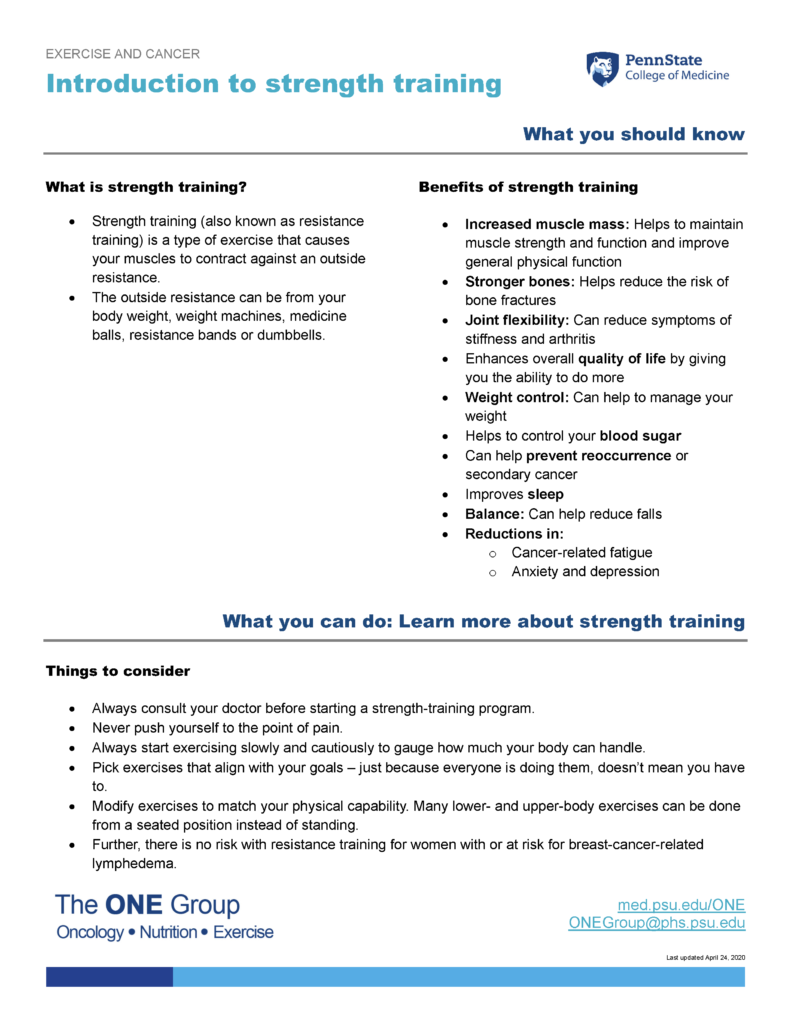Learn about the benefits of strength training for people with cancer in this guide from The ONE Group (Oncology – Nutrition – Exercise) at Penn State College of Medicine.
Jump to topic
Search
What you should know
What is strength training?
- Strength training (also known as resistance training) is a type of exercise that causes your muscles to contract against an outside resistance.
- The outside resistance can be from your body weight, weight machines, medicine balls, resistance bands or dumbbells.
Benefits of strength training
- Increased muscle mass: Helps to maintain muscle strength and function and improve general physical function
- Stronger bones: Helps reduce the risk of bone fractures
- Joint flexibility: Can reduce symptoms of stiffness and arthritis
- Enhances overall quality of life by giving you the ability to do more
- Weight control: Can help to manage your weight
- Helps to control your blood sugar
- Can help prevent reoccurrence or secondary cancer
- Improves sleep
- Balance: Can help reduce falls
- Reductions in cancer-related fatigue and anxiety and depression
What you can do: Learn more about strength training
Things to consider
- Always consult your doctor before starting a strength-training program.
- Never push yourself to the point of pain.
- Always start exercising slowly and cautiously to gauge how much your body can handle.
- Pick exercises that align with your goals – just because everyone is doing them, doesn’t mean you have to.
- Modify exercises to match your physical capability. Many lower- and upper-body exercises can be done from a seated position instead of standing.
- Further, there is no risk with resistance training for women with or at risk for breast-cancer-related lymphedema.
Where do I start?
Find the right time.
- Try to dedicate 30 to 60 minutes a day, two days a week.
Pick the right exercise equipment.
- Choose between free weights, resistance bands, weight machines, water training or body-weight exercises.
Put together a program.
- Select four to six exercises that target different major muscle groups.
- Perform two to three sets of eight to 10 repetitions of each exercise.
- Try to use a resistance that feels like an “8 out of 10” effort, with 10 being the highest effort you can give.
Set a goal.
- To get stronger, try increasing either the weight, number of repetitions, number of sets or number of exercises.
- Increase your workload once you feel comfortable with your current program.
How hard should my workout be?
- A rating of 0 means that you’re not doing any exercise and are resting. A rating of 10 means that your body is working the hardest it can.
- As you begin your strength training, try to exert yourself so that you’re rating your workout between a 3 and 4.
- After you feel you have made some positive progress, try and push yourself so that you’re increasing your difficulty rating to the 4 to 6 range. This is called “moderate intensity.” At this intensity, you should be able to speak in sentences without becoming completely out of breath.
- If at any point you feel any unexpected pain or soreness, decrease the intensity of your exercise session.
- A rating of 9 and 10 is excessive.
Intensity scale at a glance
- 10 – Maximal effort – as hard as you have ever worked
- 9
- 8 – Very hard
- 7 – Moderately hard
- 6
- 5 – Hard
- 4 – Somewhat hard (starting to breathe harder)
- 3 – Moderate
- 2 – Somewhat easy – like walking around your home
- 1 – Very easy
- 0 – At rest
Where can I find more information about aerobic and strength-training exercises?
If you are interested in starting aerobic and/or strength-training exercises, The ONE Group (Oncology – Nutrition – Exercise) provides videos demonstrating proper form for more than 50 exercises.
Notes
References
- American Cancer Society
- American College of Sports Medicine Moving Through Cancer initiative
- American Institute for Cancer Research
- National Cancer Institute

